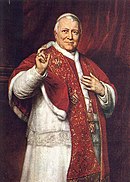Papal conclave, 1846

Coat of arms during the vacancy of the Holy See
|
|
| Dates and location | |
|---|---|
| 14–16 June 1846 Quirinal Palace, Papal States |
|
| Key officials | |
| Dean | Ludovico Micara |
| Sub-Dean | Vincenzo Macchi |
| Camerlengo | Tommaso Riario Sforza |
| Protopriest | Carlo Oppizzoni |
| Protodeacon | Tommaso Riario Sforza |
| Election | |
| Candidates | Luigi Lambruschini |
| Ballots | 4 |
| Elected Pope | |
|
Giovanni Maria Mastai-Ferretti (Name taken: Pius IX) |
|
 |
|
The death of Pope Gregory XVI on 1 June 1846 triggered the Papal conclave of 1846. Fifty of the 62 members of the College of Cardinals assembled in the Quirinal Palace, one of the papal palaces in Rome and the seat of two earlier 19th century conclaves. The conclave began on 14 June and had to elect a pope who would not only be head of the Catholic Church but also the head of state and government of the Papal States, the extensive lands around Rome and Northern Italy which the Catholic Church governed.
It was the issue of the government of the Papal States that was to prove central to the 1846 conclave. The College of Cardinals was split into two factions. The conservatives wished to see a continuation of papal absolutism in the governance of the Papal States, a continuation of the hardline policies of Pope Gregory XVI and his right-wing Secretary of State, Luigi Lambruschini, while the liberals wished for some measure of moderate reform and favored two candidates in Tommaso Pasquale Gizzi and Giovanni Maria Mastai-Ferretti. A fourth papabile was Cardinal Ludovico Micara, the Dean of the College of Cardinals, who was favored by the residents of Rome itself but he never gained support among the cardinals. Lambruschini himself was the leader of the conservatives while Tommaso Bernetti who had served as Pro-Secretary of State under Pope Leo XII and the early part of Pope Gregory XVI's reign was the leader of the liberal faction.
Lambruschini received a majority of the votes in the early ballots, but failed to achieve the required two-thirds majority. Cardinal Mastai-Ferretti reportedly received 15 votes with the rest going to Lambruschini and Gizzi. Cardinal Gizzi was favored by the French government but failed to get additional support from the cardinals and the conclave ended up ultimately as a contest between Cardinals Lambruschini and Mastai-Ferretti. In the meantime, Cardinal Bernetti reportedly received information that Karl Kajetan von Gaisruck, the Austrian Archbishop of Milan, was on his way to the conclave to veto the election of Mastai-Ferretti and realized that if Mastai-Ferretti was to be elected he had to convince the cardinals within a few hours or accept the election of Lambruschini. Bernetti then on his own initiative personally convinced the majority of the electors to switch their support to Mastai-Ferretti. Cardinal Mastai-Ferretti himself however made no effort to campaign for the papacy, made no promises and maintained aloofness throughout the process. Despite not having campaigned for the papacy, Cardinal Mastai-Ferretti was perceived to be "a glamorous candidate, ardent, emotional with a gift for friendship and a track-record of generosity even towards anti-Clericals and Carbonari. He was a patriot, known to be critical of Gregory XVI " Faced with deadlock and persuaded by Bernetti to keep Lambruschini from being elected pope, liberals and moderates decided to cast their votes for Mastai-Ferretti in a move that contradicted the general mood throughout Europe.
...
Wikipedia
